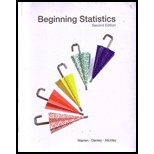
(a)
To find:
The specified
Answer to Problem 25E
Solution:
Value of the required probability is 0.9952.
Explanation of Solution
Given information:
Ronnie owns a fireworks stand and knows that in the fireworks business, 1 out of every 13 fireworks is a dud. Suppose that Juanita buys 10 firecrackers at Ronnie’s stand.
Formula used:
For a binomial random variable
The formula to calculate
Here,
The formula to calculate
Calculation:
Consider the event “duds” as a success.
Probability of winning is 1 out of 13.
Probability of success is
Number of trial is 10.
Compute the probability for no more than 3 successes.
Substitute 3 for
Substitute 10 for
Substitute 10 for
Substitute 10 for
Substitute 10 for
Add the values of
Conclusion:
Thus, the probability that no more than 3 are duds is 0.9952.
(b)
To find:
The specified probability for the given scenario.
Answer to Problem 25E
Solution:
Value of the required probability is 0.45.
Explanation of Solution
Given information:
Ronnie owns a fireworks stand and knows that in the fireworks business, 1 out of every 13 fireworks is a dud. Suppose that Juanita buys 10 firecrackers at Ronnie’s stand.
Formula used:
For a binomial random variable
The formula to calculate
Calculation:
Consider the event “duds” as a success.
Probability of winning is 1 out of 13.
Probability of success is
Number of trial is 10.
Compute the probability for no success.
Substitute 10 for
Conclusion:
Thus, the probability of no duds is 0.45.
(c)
To find:
The specified probability for the given scenario.
(c)
Answer to Problem 25E
Solution:
Value of the required probability is 0.00003.
Explanation of Solution
Given information:
Ronnie owns a fireworks stand and knows that in the fireworks business, 1 out of every 13 fireworks is a dud. Suppose that Juanita buys 10 firecrackers at Ronnie’s stand.
Formula used:
For a binomial random variable
The formula to calculate
Here,
The formula to calculate
Calculation:
Consider the event “duds” as a success.
Probability of winning is 1 out of 13.
Probability of success is
Number of trial is 10.
Consider number of more than half of the crackers as a number of success.
Compute the probability for more than 5 successes.
Substitute 5 for
Substitute 10 for
Substitute 10 for
Substitute 10 for
Substitute 10 for
Substitute 10 for
Add all the values of
Conclusion:
Thus, the probability of more than half duds is 0.00003.
Want to see more full solutions like this?
Chapter 5 Solutions
Beginning Statistics, 2nd Edition
- Business Discussarrow_forwardThe following data represent total ventilation measured in liters of air per minute per square meter of body area for two independent (and randomly chosen) samples. Analyze these data using the appropriate non-parametric hypothesis testarrow_forwardeach column represents before & after measurements on the same individual. Analyze with the appropriate non-parametric hypothesis test for a paired design.arrow_forward
- Should you be confident in applying your regression equation to estimate the heart rate of a python at 35°C? Why or why not?arrow_forwardGiven your fitted regression line, what would be the residual for snake #5 (10 C)?arrow_forwardCalculate the 95% confidence interval around your estimate of r using Fisher’s z-transformation. In your final answer, make sure to back-transform to the original units.arrow_forward
 MATLAB: An Introduction with ApplicationsStatisticsISBN:9781119256830Author:Amos GilatPublisher:John Wiley & Sons Inc
MATLAB: An Introduction with ApplicationsStatisticsISBN:9781119256830Author:Amos GilatPublisher:John Wiley & Sons Inc Probability and Statistics for Engineering and th...StatisticsISBN:9781305251809Author:Jay L. DevorePublisher:Cengage Learning
Probability and Statistics for Engineering and th...StatisticsISBN:9781305251809Author:Jay L. DevorePublisher:Cengage Learning Statistics for The Behavioral Sciences (MindTap C...StatisticsISBN:9781305504912Author:Frederick J Gravetter, Larry B. WallnauPublisher:Cengage Learning
Statistics for The Behavioral Sciences (MindTap C...StatisticsISBN:9781305504912Author:Frederick J Gravetter, Larry B. WallnauPublisher:Cengage Learning Elementary Statistics: Picturing the World (7th E...StatisticsISBN:9780134683416Author:Ron Larson, Betsy FarberPublisher:PEARSON
Elementary Statistics: Picturing the World (7th E...StatisticsISBN:9780134683416Author:Ron Larson, Betsy FarberPublisher:PEARSON The Basic Practice of StatisticsStatisticsISBN:9781319042578Author:David S. Moore, William I. Notz, Michael A. FlignerPublisher:W. H. Freeman
The Basic Practice of StatisticsStatisticsISBN:9781319042578Author:David S. Moore, William I. Notz, Michael A. FlignerPublisher:W. H. Freeman Introduction to the Practice of StatisticsStatisticsISBN:9781319013387Author:David S. Moore, George P. McCabe, Bruce A. CraigPublisher:W. H. Freeman
Introduction to the Practice of StatisticsStatisticsISBN:9781319013387Author:David S. Moore, George P. McCabe, Bruce A. CraigPublisher:W. H. Freeman





